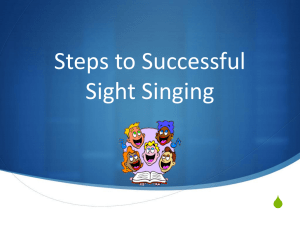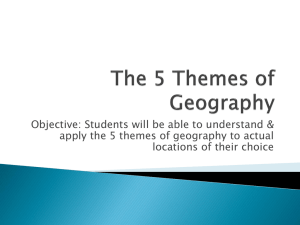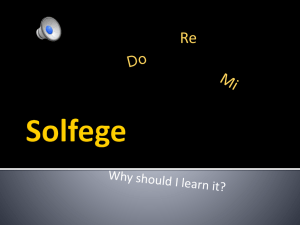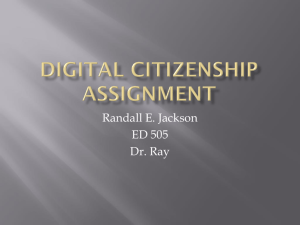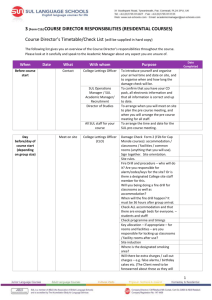Copyright & Fair Use: Guidelines for Education
advertisement
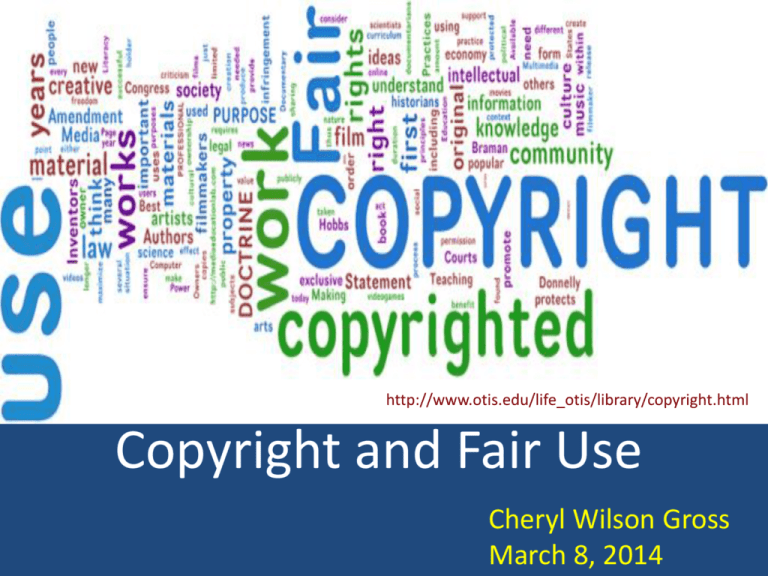
http://www.otis.edu/life_otis/library/copyright.html Copyright and Fair Use Cheryl Wilson Gross March 8, 2014 What is Copyright? Copyright = Protection (USCO, 2014) – Promotes and encourages knowledge – Protects rights of authors and inventors – Allows temporary ownership of their work – Protects both published and unpublished works – Gives owners exclusive rights of http://www.ikeepsafe.org/w pcontent/uploads/2012/09/Fa ir-Use.png • Reproduction of copies • Preparation of derivatives (books into movies, plays, or TV programs) • Distribution of copies for sale • Exhibition or presentation • Performance Copyright: Qualifications (CCC, 2014) Protected • Original works • Exist in some physical form • Creative expression • Includes literary, dramatic, artistic, musical, intellectual, architectural works Not Protected • Ideas, procedures, and methods • Facts and data – historical, scientific, biological, or news • Logos and taglines • Public domain – expired and uncopyrighted works • Titles, names, slogans, or phrases • Created by U.S. Government Copyright: Duration Lasts the shorter of (USCO, 2014): – Life of the author / inventor plus 70 years – 95 years from publication date • Works created as an employee or contractor • Published under a pseudonym • Published anonymously – 120 years from creation date • Unpublished works Copyright: Infringement • Penalties for copyright violations (USCO, 2014) – Injunction to prevent or restrain usage temporarily or permanently – Impoundment of materials including copies, recordings, negatives, and records – Payment of actual and statutory damages, profits, attorney fees, and court costs – Payment for each work infringed from $200 $150,000 – Criminal prosecution with fines not to exceed $2,500 and/or imprisonment of not more than 5 years Fair Use: Definition (SUL, 1997) • Based on belief that public is entitled to free use of copyrighted material • Key is usage of copyrighted material • Judgment is subjective • Give credit where credit is due - CITATION http://www.erikjheels.com/2007-07-18-drawing-that-explains-copyright-law.html Fair Use: Categories (SUL, 1997) • Allows use of copyrighted materials for parody and commentary / criticism • Allows use for limited time and for transformative purposes • Reasonable for teaching, research, and news reporting • Allowable for creativity and expansion of someone’s existing knowledge without fear http://www.ipprospective.com/copyrightcaucus/copyright-fair-use-empirical-study-by-barton- Fair Use: Guidelines Fair Use guidelines include four factors (SUL, 1997): • Nature of the original work • Character and purpose of its use • How its use will effect future marketability and value • Amount of content in proportion to the original work is being used http://www.thegeminigeek.com/wpcontent/uploads/2009/10/Fair-Use.jpg Fair Use Examples (SUL, 1997) • Quoting a few lines of a song • Summarizing or quoting from newspaper or magazine articles • Copying paragraphs from newspaper or magazine articles for educational purposes by students and/or teachers • Copying a work for purpose of ridicule in a comedic manner http://viz.cwrl.utexas.edu/files/Character-Comparison.png Multimedia in the Classroom Exceptions for educational purposes (CCC, 2014) – Section 107 refers to fair use and includes activities such as parody creation, using quotes for example or commentary, and unplanned replicas of materials. – Section 108 discusses copying by archives and libraries and includes activities such as restoring or replacing damaged, lost, or outdated copies; supporter requests for complete works; interlibrary loans; and archiving. – Section 109 speaks of the first sale and allows for libraries to loan copies of works and to sell pre-owned books. – Section 110 refers to performance and display in the classroom, which permits certain types of content use in the classroom and in distance education. Multimedia Fair Use Guidelines (NCPS, 1997) • Words by others – No more than 1000 words or 10% – Poems: http://img.talkandroid.com/uploads/20 1/stack_of_books.jpg • entire work or no more than 250 words if a longer poem • 5 or less poems or excerpts from poems of multiple authors or anthology • No more than 3 poems or quotes from one author • Music – No more than 10% not to exceed 30 seconds of musical composition or sound recording – Any changes made cannot alter the basic melody or its character http://evidencebasedliving.human.cornell.edu/ files/2013/07/music_notes-1z5rh82.jpg Multimedia Fair Use Guidelines (UMKC, 2014) • Film / TV / Documentary – Usage: No more than 10% not to exceed 3 minutes – Can view entire TV program or film • Nonprofit education institution • Face-to-face classroom setting • Must be part of instructional activities • Copy must be lawfully made http://media.salon.com/2012/12/sh utterstock_92369284.jpg – Netflix and video purchases or rentals are ok – YouTube as long as using an embedded link Using TV Programs in the Classroom • Guidelines for taping (SUL, 1997) – Only programs that are broadcasted to homes and schools – Taping should be preformed by school – Shown only 1st 10 consecutive school days after taping has been made – Shown only in educational institution – Only a limited number can be made – Cannot be altered or joined with other programs – Destroyed no later than 45 days after creation http://www.colum.edu/Admissions/image program%20headers/Television.jpg Obtaining Permission Before using copyrighted materials, follow these steps (SUL, 1997). http://www.nolo.com/products/media/catal g/product/cache/1/image/9df78eab33525d0 8d6e5fb8d27136e95/r/i/riper5_1_1.gif – Determination needs to be made if permission is necessary. – The owner of the material must be identified. – Based on usage, identification of what rights are needed. – The owner must be contacted and negotiations made to see if compensation is mandatory. – Make sure that permission is in writing. Web Posting Considerations • Commercialize or non-commercialize usage (UTL, 2007) • Open access (UTL, 2007) • Licensing via Creative Commons (CC, 2013) http://co.creativecommons.org/wpcontent/themes/Equilibrium/header-cccolombia.jpg – Irrevocability – Material or work to be licensed (everything but software and hardware – Adequacy of the license to protect – Licenses cover editing, building upon, remixing, copying, and distribution Summary http://artclasswithlmj.files.wordpress.com/2012/11/fair-use-map.jpg References • Copyright Clearance Center (CCC). (2014). Copyright protection in the United States. Retrieved from http://www.copyright.com/content/cc3/en/toolbar/education/get -thefacts/purpose_of_copyright/copyright_protection_in_the_united _states.html. • Creative Commons (CC). (2013). Before licensing. Retrieved from http://wiki.creativecommons.org/Before_Licensing. • Harper, G.K. (2007). Copyright crash course. Retrieved from http://copyright.lib.utexas.edu/cprtmgt.html. • North Carolina Public Schools (NCPS). (1997). Copyright in an electronic environment. Retrieved from http://www.ncpublicschools.org/copyright1.html. References • Stanford University Library (SUL). (2014). Stanford copyright and fair use. Retrieved from http://fairuse.stanford.edu. • UMKC Library Guides (UMKC). (2014). Media in the classroom. Retrieved from http://libguides.library.umkc.edu/content.php?pid=31006&sid=79 4429. • U. S. Copyright Office (USCO). (2014). Copyright basics. Retrieved from http://www.copyright.gov/. • U. S. Copyright Office (USCO). (2014). Chapter 5: Copyright infringement and remedies. Retrieved from http://www.copyright.gov/title17/.

